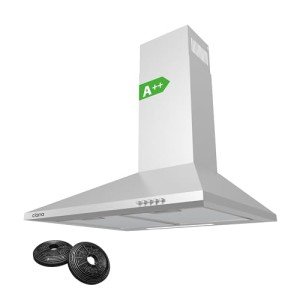
Island Cooker Hood
Add a review FollowOverview
-
Sectors Medical Technician
-
Posted Jobs 0
-
Viewed 3
Company Description
5 Killer Quora Answers On Chimney Cooker Hoods
Understanding Chimney Cooker Hoods: A Comprehensive Guide
Chimney cooker hoods have actually ended up being a staple in modern kitchens, merging performance with elegant aesthetics. These ventilation systems are designed to remove smoke, smells, and air-borne grease from the kitchen, improving air quality while complementing kitchen decoration. In this blog post, we will check out various elements of chimney cooker hoods, their benefits, types, setup tips, and upkeep guidance.
What is a Chimney Cooker Hood?
A chimney cooker hood, often called a chimney hood, is a kitchen appliance installed above the cooking range to extract smoke, grease, steam, and smells while cooking. Its design features a vertical structure looking like a chimney, giving it its name. These hoods can be ducted (venting air exterior) or recirculating (filtering and reestablishing air), accommodating varying kitchen setups.
Secret Features of Chimney Cooker Hoods
| Design | Smooth and modern, fits different kitchen styles |
| Sizes | Available in several widths and heights |
| Filters | Typically equipped with grease and charcoal filters for optimal performance |
| Controls | May consist of buttons, touch, or push-button controls |
| Lighting | Features incorporated lighting for much better presence while cooking |
Advantages of Using Chimney Cooker Hoods
-
Improved Air Quality: Chimney hoods successfully remove harmful vapors, ensuring a much healthier cooking environment.
-
Smell Elimination: They help eliminate cooking odors, preventing them from settling in furnishings or upholstery.
-
Grease Reduction: A chimney hood limitations grease accumulation on surfaces, making kitchen cleansing easier.
-
Improves Kitchen Aesthetics: Available in numerous styles, they can act as a centerpiece in kitchen design.
-
Increased Kitchen Comfort: By improving air blood circulation, they make cooking more enjoyable, especially in restricted kitchen spaces.
Types of Chimney Cooker Hoods
Chimney hoods can be found in various types, each designed to fit particular needs. Here are the most common types:
| Wall-Mounted | Set up versus a wall above the cooking range. | Space-saving, trendy, and flexible. | Requires wall area; may be more pricey. |
| Island | Suspended from the ceiling above an island cooking range. | Provides visual appeal and effective ventilation. | Setup can be complex; greater expense. |
| Under-Cabinet | Installed under kitchen cabinets. | Suitable for kitchens with limited area. | Less visual appeal; may limit air flow. |
| Integrated | Integrated into kitchen cabinetry for a seamless appearance. | Hidden style, makes the most of space. | Normally more costly; may limit power. |
Installation Tips for Chimney Cooker Hoods
Setting up a chimney cooker hood can be a simple procedure, but appropriate guidelines ought to be followed. Here is a list of essential installation suggestions:
-
Select the Right Height: The ideal height for installation is normally in between 26-30 inches above the cooking surface area.
-
Think about the Ductwork: Ensure appropriate ducting remains in location if you choose a ducted design. Short, straight duct runs reduce loss of suction.
-
Confirm Electrical Needs: Check the hood’s specifications for electrical requirements and make sure correct circuitry.
-
Follow Manufacturer Instructions: Each brand might have distinct treatments; constantly describe the manufacturer’s guide.
-
Protect Proper Ventilation: Ensure appropriate ventilation outside the home for ducted hoods, preventing backdrafts.
Frequently Asked Questions About Chimney Cooker Hoods
1. How do I know which size chimney hood to purchase?To figure out the right size, think about the width of your cooking range. The hood needs to match or be slightly bigger than the cooking device, generally 3-6 inches broader.
2. Do chimney hoods work without ducting?Yes, recirculating (non-ducted) models can filter and purify the air before launching it back into the kitchen. Nevertheless, they might be less effective than ducted variations.
3. How frequently should I clean the filters?It’s recommended to clean grease filters every month and replace charcoal filters roughly every 6 months, depending on usage.
4. Can chimney hoods be utilized over all types of cookers?A lot of designs are suitable for gas and electrical cookers. Nevertheless, check the manufacturer’s standards to guarantee compatibility.
5. What is the average expense of chimney cooker hoods?Costs vary substantially, varying anywhere from ₤ 100 for standard models to over ₤ 2,000 for high-end, designer variations.

Upkeep of Chimney Cooker Hoods
To guarantee longevity and efficient efficiency of chimney cooker hoods, routine upkeep is important. It can prevent breakdowns and maintain ideal duct efficiency.
Upkeep Checklist
- Clean the Filters: Remove and clean grease filters frequently.
- Inspect the Fan: Inspect and clean up the fan and motor to ensure they function correctly.
- Examine Ductwork: Periodically check ducts for blockages or accumulation.
- Polish the Surface: Use appropriate cleaning products to prevent scratches and keep shine on the exterior.
- Evaluate the Lighting: Regularly examine light functions and replace burnt-out bulbs promptly.
Chimney cooker hoods are an integral part of modern kitchen design and functionality. They enhance the cooking experience while effectively improving air quality. With different styles and alternatives offered, discovering the perfect chimney hood to suit your requirements becomes an attainable task. By comprehending their types, advantages, and upkeep, one can make informed decisions, ensuring a beautifully aerated kitchen for years to come.


